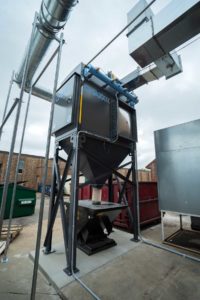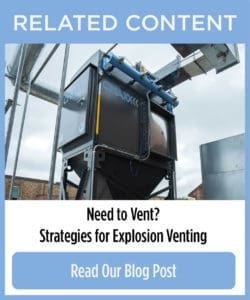According to NFPA standards, explosion venting is a key part of dust collector safety. NFPA 68, the Standard on Explosion Protection by Deflagration Venting, lays out these guidelines. Dust collector explosion venting, also called deflagration venting, allows pressure to safely escape during a fire.
Without explosion relief venting, a dust collector fire can cause a rapid increase in pressure inside the enclosed space. Then, with no safe outlet, the growing pressure can damage the dust collector or even the entire facility. So it puts lives at risk.
 What NFPA 68 Says About Explosion Venting for Dust Collectors
What NFPA 68 Says About Explosion Venting for Dust Collectors
NFPA 68 specifies what explosion venting must do to meet standards. Firstly, the explosion or deflagration venting must protect people from harm:
- Prevent structural failure that causes harm to people in the area
- Direct venting away from the presence of people in the area
- Make sure that materials that are health hazards vent outside
Secondly, the venting must prevent property from damage:
- Limit damage to the enclosure by venting pressure
- Avoid ignition of nearby items or property
- Direct projectile materials away from potential damage
In other words, the force of the deflagration or explosion needs to vent away from people or things that it could damage. Also, the vent design must not result in pieces of material being flung into the neighbor’s office building in the event of an explosion.
The Dust Collector Explosion Pentagon
Why do dust collectors in particular need explosion venting?
For an explosion to occur, the five elements of the dust explosion pentagon must be met. A dust collector is a perfect place for all five of these things to happen.
First of all, if you have combustible dust, you have fuel for a fire. Then, if that dust disperses in air, as it would in a dust collector, it is much more explosive. Next, assuming the dust collector has air inside it, the fire has oxygen. Then a spark, electrical component, or overheated piece of equipment can provide the ignition. Finally, to make it a true explosion, the dust cloud is inside an enclosed space.
That enclosed space creates the biggest danger in combustible dust collection. With all five elements of the pentagon met, the dust collector becomes an enclosed space full of oxygen and fuel. One spark can cause ignition.
In a dust collector without proper explosion relief venting, fuel burning in the closed space will create a rapid increase in pressure. With no escape, the pressure will create its own path to vent. Injury to people and damage to property may result.
By using the appropriate dust collector explosion venting that meets NFPA 68 standards, that pressure has a safe exit. Designed to rupture when pressure builds, the vent provides the easiest escape route for the gasses and flames.
Most cars built today have a “crumple zone”. This area of the car absorbs the force of impact by acting as a weak point, designed to take the damage so the rest of the car doesn’t. An explosion vent for your dust collector acts in a similar way: by design, it’s the weak point, the place that will rupture before the rest of the dust collector does.
Explosion Vent Design and Options for NFPA 68
 NFPA 68 gives formulas to calculate the exact size of an explosion relief vent for dust collectors. If it’s not feasible to point the vent in a safe direction, standards allow for the use of a blast deflector plate. This plate will usually face the vent at an angle of somewhere between 45 degrees and 60 degrees. The blast deflector plate must take the full force of the vented explosion and redirect it.
NFPA 68 gives formulas to calculate the exact size of an explosion relief vent for dust collectors. If it’s not feasible to point the vent in a safe direction, standards allow for the use of a blast deflector plate. This plate will usually face the vent at an angle of somewhere between 45 degrees and 60 degrees. The blast deflector plate must take the full force of the vented explosion and redirect it.
Dust collectors located indoors usually have ductwork that vents to the outdoors. NFPA 68 allows this as long as the ductwork is strong enough to withstand the potential damage. Sometimes, though, an indoor dust collector has no vent to the outside. In this case, you have an option, but not a cheap one.
Flameless explosion vents, as the NFPA defines them, act as flame arrestors, completely stopping flames. They also provide particulate retention, which means that no particles or flaming material can get through. These deflagration venting devices will add significant expense to a dust collection project.
The most common type of explosion relief on dust collectors is an explosion vent, also sometimes called a burst panel. An attached burst detector can tell you whether the panel has been subjected to enough force to burst it, even if it looks OK. Even minor damage to the explosion vent means the dust collector could have been subjected to internal pressure. This means it must be checked for any other damage.
Other NFPA Standards for Dust Collector Explosion Venting
Most other NFPA standards relating to explosion venting refer back to NFPA 68. It contains the most detailed standards and calculations. However, some materials use special equipment or present special challenges. If your facility handles combustible dust, you’ll need to be aware of several other standards:
- Fundamentals of Combustible Dust: NFPA 652
- Prevention of Fire and Dust Explosions from the Manufacturing, Processing, and Handling of Combustible Particulate Solids: NFPA 54
- Explosion Prevention Systems: NFPA 69
The first two standards combine a lot of the information once scattered across other standards. NFPA 69, the sister standard to NFPA 68, covers many explosion prevention and control systems. Many NFPA standards deal with very specific industries or materials:
- Prevention of Fires and Dust Explosions in Agricultural and Food Processing Facilities: NFPA 61
- Combustible Metals: NFPA 484 (separate standards exist for aluminum, lithium, magnesium, titanium, and zirconium)
- Prevention of Fires and Explosions in Wood Processing and Woodworking Facilities: NFPA 664
For more information about these NFPA standards, keep an eye on our future blog posts by following us on Facebook or Linkedin so you don’t miss any useful information!


